Publications to date
-
+ 2025
-
Fusion of Middle Ear Optical Coherence Tomography and Computed Tomography
Abstract: In this case series including 3 patients, OCT and CT imaging produced complementary diagnostic information, with CT offering unobstructed images of bony anatomy and OCT providing the ability to visualize soft tissue.
JAMA Otolaryngology-Head & Neck Surgery doi:10.1001/jamaoto.2025.0043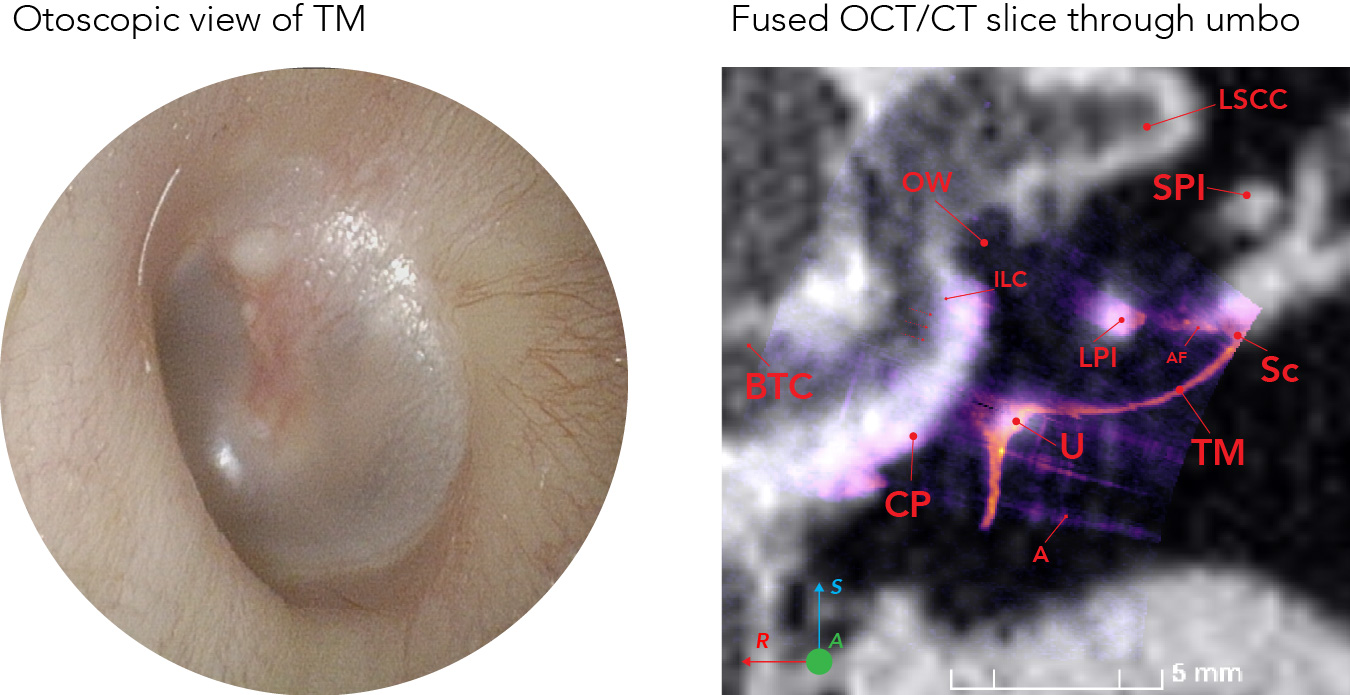
-
-
Clinical Applications of Handheld Middle Ear Optical Coherence Tomography (ME-OCT) with Live Volumetric Visualization: Clinical Applications of 4D ME-OCT
Abstract: Optical coherence tomography (OCT) is a real-time, non-invasive, nonionizing imaging modality with an increasing popularity in clinical otology as it combines the advantages of structural imaging and functional diagnostics of the middle ear space without disrupting the tympanic membrane at the point-of-care. Middle ear OCT(ME-OCT) offers static structural imaging and Doppler vibrometry of the ossicular chain, offering complementary information for clinical decisions. However, the existing modalities limit the temporal perception of visualizing ME dynamics in vivo. We present a custom-built OCT system which is capable of continuous 3D acquisition and visualization (4D OCT) of the ME and its utility in clinical diagnosis where such improved modality provides objective visual documentation of otologic examinations., i.e., Valsalva maneuver. We also show that such capabilities afford visual aids in surgical exploration, i.e., partial ossicular prosthesis (PORP) and cochlear implant (CI) surgeries.
Otology & Neurotology 10.1097/MAO.0000000000004188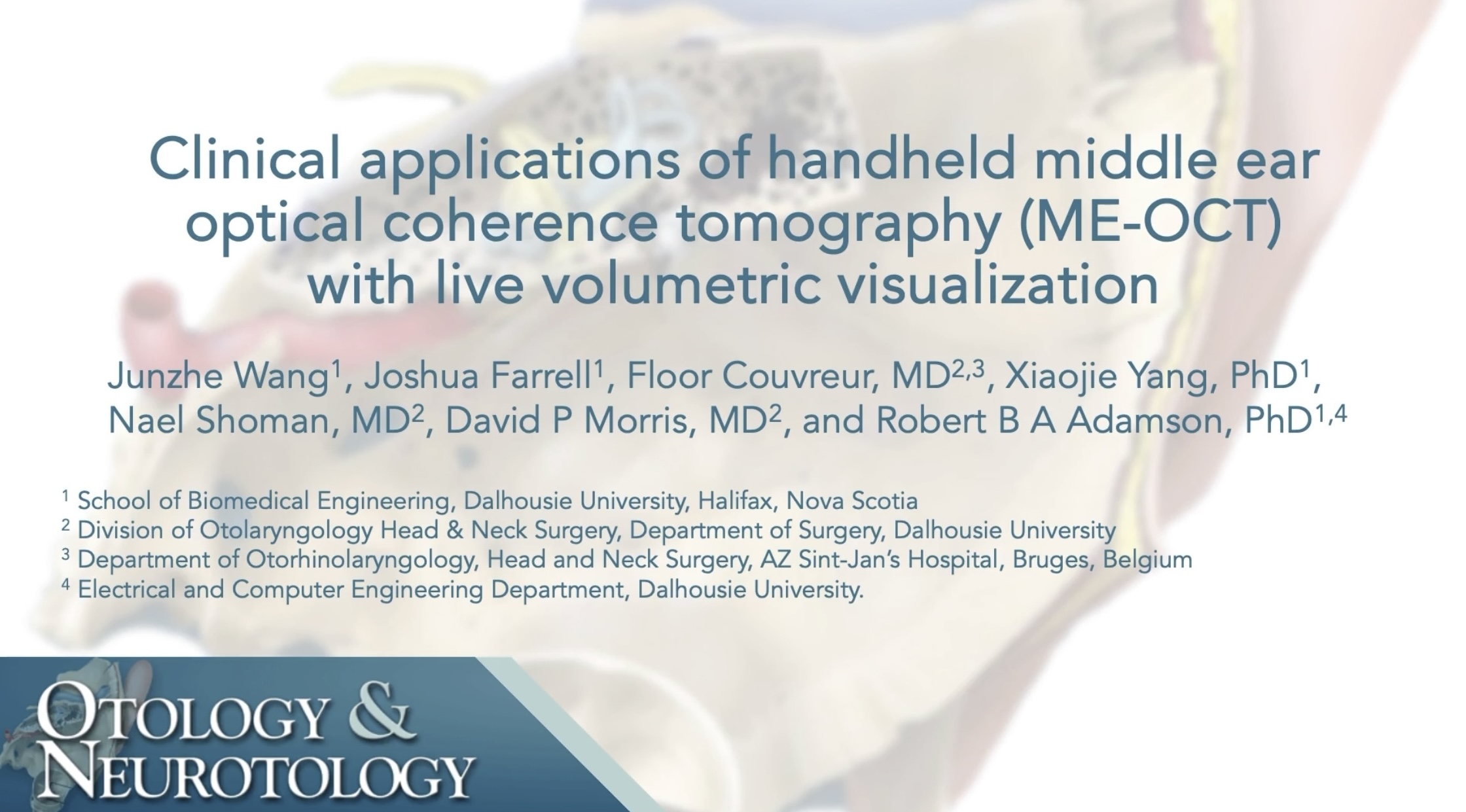
-
Improved middle ear imaging with optical coherence tomography for clinical otology
Abstract: Conductive hearing loss (CHL) is a widespread and debilitating condition that affects millions of individuals worldwide. This impairment results from disruptions in the transmission of sound waves from the tympanic membrane (TM) to the inner ear. Unfortunately, existing diagnostic tools are often inadequate in pinpointing the root causes of CHL, leading to uncertainty when determining the most appropriate clinical management plans. Optical coherence tomography (OCT) is an emerging imaging modality that offers non-invasive, high-resolution structural images of the middle ear. It also allows for measuring vibrations in middle ear structures in response to sound through an intact TM. Like all biomedical imaging methods, middle ear OCT (ME-OCT) aims to extract diagnostically significant information from the acquired images. However, its clinical application is limited by suboptimal image quality, due in large part to sidelobe artefacts and the effective imaging depth in the presence of optically opaque structures, such as cartilage tympanoplasty. This thesis introduces two approaches to improve middle ear visualisation using OCT without modifying the existing imaging system. First, it presents a method that employs a convolutional basis pursuit framework to eliminate imaging artefacts related to strong reflections at tissue-air interfaces, which impede accurate morphology-based diagnoses. Second, it explores the potential of an optical clearing agent using a topical glycerol treatment to increase the transparency of cartilage grafts, allowing for OCT visualisation of the post-operative middle ear. The enhanced image quality could facilitate more precise CHL diagnoses based on morphological changes of middle structures, providing clinicians with more accurate and reliable diagnostics using ME-OCT.
Link
-
Geometrically accurate real-time volumetric visualization of the middle ear using optical coherence tomography
Abstract: We introduce a novel system for geometrically accurate, continuous, live, volumetric middle ear optical coherence tomography imaging over a 10.9 mm × 30° × 30° field of view (FOV) from a handheld imaging probe. The system employs a discretized spiral scanning (DC-SC) pattern to rapidly collect volumetric data and applies real-time scan conversion and lateral angular distortion correction to reduce geometric inaccuracies to below the system’s lateral resolution over 92% of the FOV. We validate the geometric accuracy of the resulting images through comparison with co-registered micro-computed tomography (micro-CT) volumes of a phantom target and a cadaveric middle ear. The system’s real-time volumetric imaging capabilities are assessed by imaging the ear of a healthy subject while performing dynamic pressurization of the middle ear in a Valsalva maneuver.
Biomedical Optics Express DOI: 10.1364/BOE.488845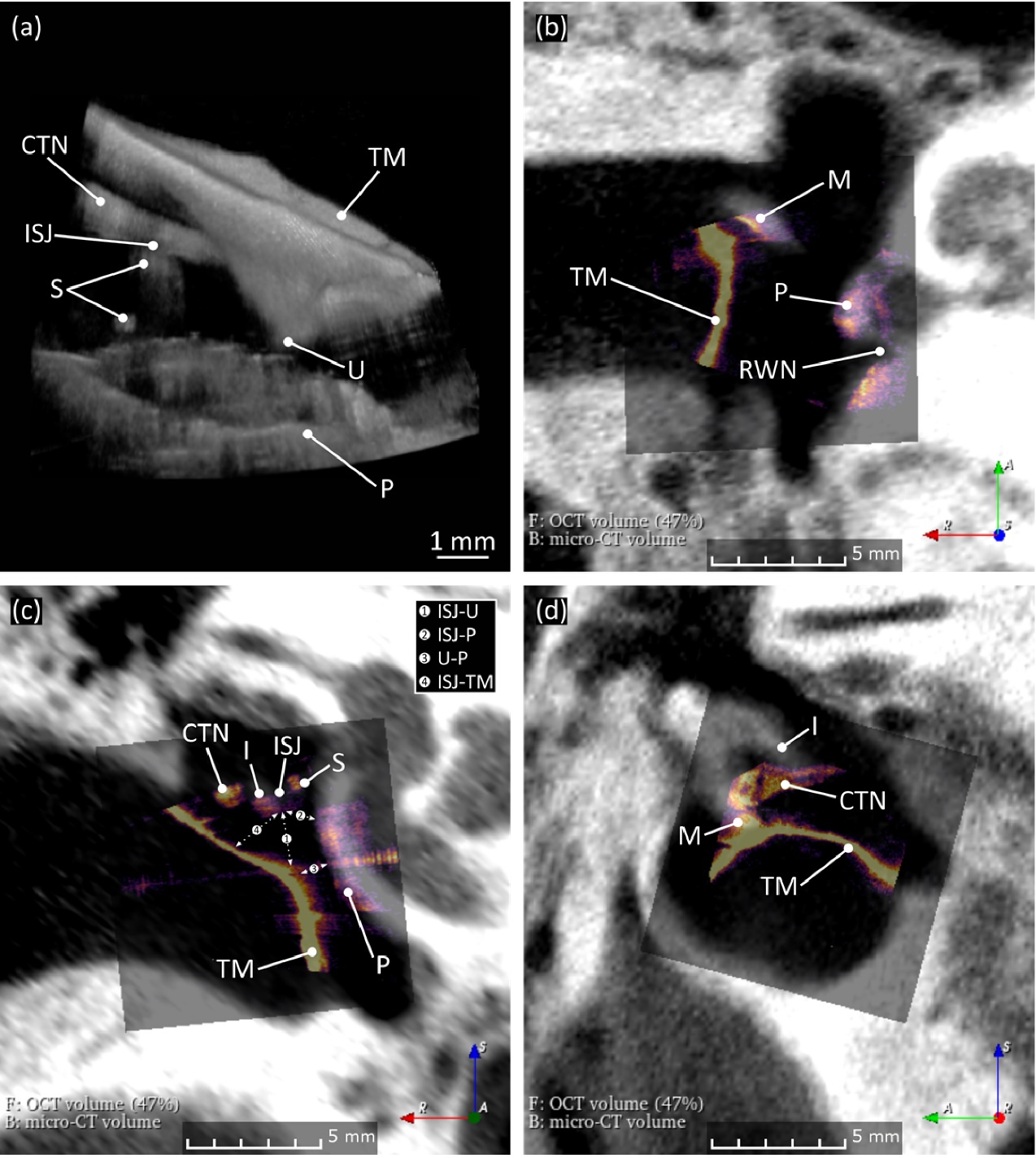
-
Transtympanic visualization of cochlear implant placement with optical coherence tomography: A pilot study
Abstract: This study investigated the use of transtympanic middle ear optical coherence tomography (ME-OCT) in assessing the placement of cochlear implants (CIs) in situ. A 72-year-old man with bilateral progressive sensorineural hearing loss due to noise exposure received a CI in his right ear and was evaluated three months later. A custom-built swept source ME-OCT system was utilized for imaging, capturing two- and three-dimensional images of the patient's CI. Additionally, transtympanic OCT imaging was performed on a human cadaveric temporal bone to visualize the insertion and removal of a similar CI. The images and videos were analyzed to evaluate the visibility of implant features and to quantify the insertion depth of the CI. Both in the patient and the cadaveric temporal bone, the CI electrode was clearly visible in the round window niche, and its characteristic design features enabled quantification of insertion depth. The study concludes that ME-OCT could serve as a noninvasive and nonionizing method in clinical settings to confirm CI placement and measure insertion depth, demonstrating its potential utility in postoperative ear assessments.
Otology & Neurotology DOI: 10.1097/MAO.0000000000003635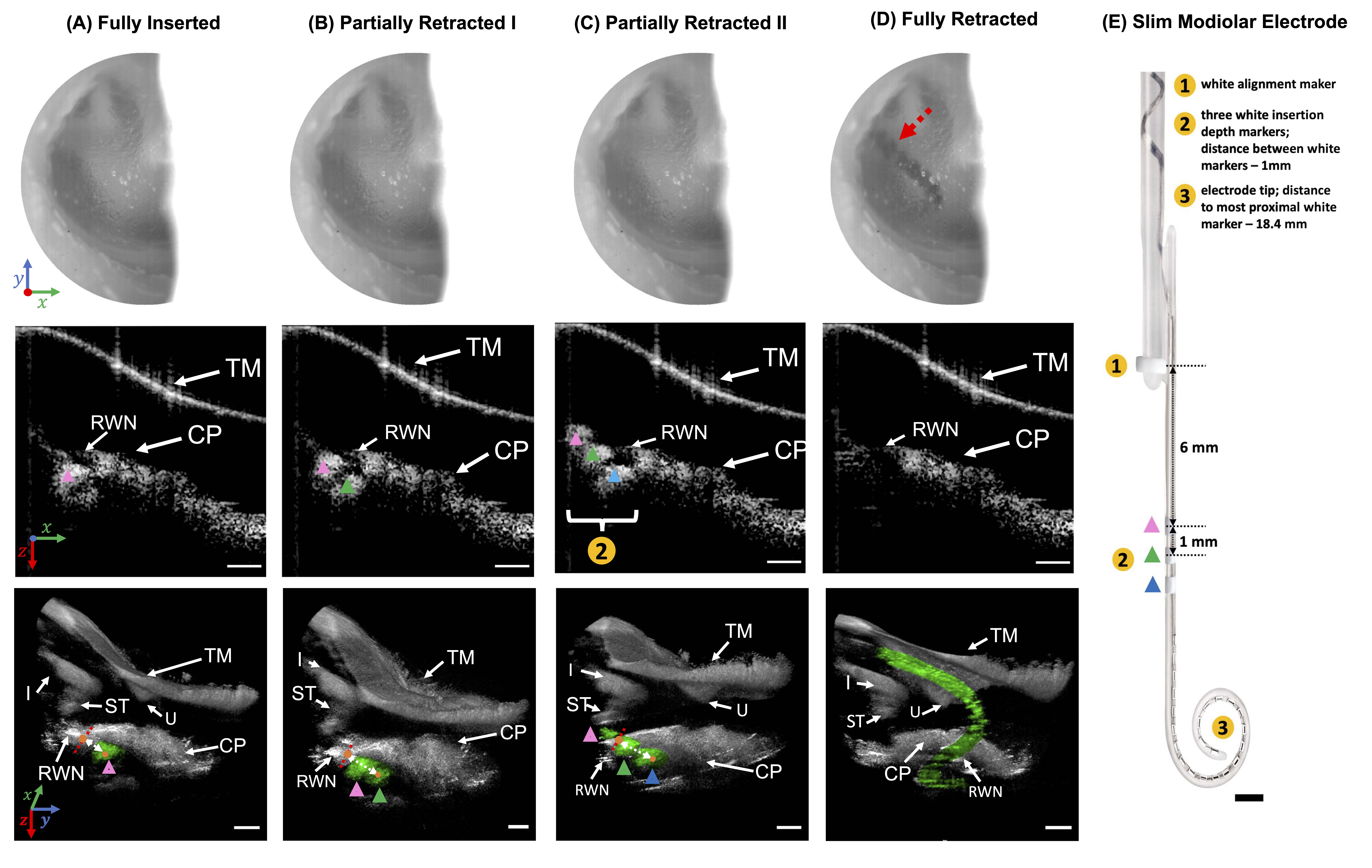
-
Optical clearing agents for optical imaging through cartilage tympanoplasties: A preclinical feasibility study
Abstract: In this study, we explored the potential of optical clearing agents (OCAs) for rendering cartilage tympanoplasty grafts transparent enough to visualize middle ear structures using optical coherence tomography (OCT). The experiment involved treating human tragal cartilage with glycerol, a common OCA, and measuring the optical attenuation and dimensional changes of the graft as it cleared. This was followed by a separate experiment using a human cadaveric temporal bone prepared to simulate an ossiculoplasty surgery with a cartilage replacement of the tympanic membrane and a partial ossicular replacement prosthesis (PORP). The results showed a significant decrease in the optical attenuation of 0.4mm cartilage grafts treated with glycerol, with the effects being reversible after saline washout. In the temporal bone experiment, glycerol treatment of the cartilage graft led to substantial increases in signal-to-noise ratio and contrast, enhancing the visualization of the PORP through the graft using OCT. These findings suggest that OCAs could be a valuable tool in OCT imaging of post-surgical ears with cartilage grafts.
Otology & Neurotology DOI: 10.1097/MAO.0000000000003502
-
Convolutional dictionary learning for blind deconvolution of optical coherence tomography images
Abstract: In this study, we demonstrate a sparsity-regularized, complex, blind deconvolution method for removing sidelobe artefacts and stochastic noise from optical coherence tomography (OCT) images. Our method estimates the complex scattering amplitude of tissue on a line-by-line basis by estimating and deconvolving the complex, one-dimensional axial point spread function (PSF) from measured OCT A-line data. We also present a strategy for employing a sparsity weighting mask to mitigate the loss of speckle brightness within tissue-containing regions caused by the sparse deconvolution. Qualitative and quantitative analyses show that this approach suppresses sidelobe artefacts and background noise better than traditional spectral reshaping techniques, with negligible loss of tissue structure. The technique is particularly useful for emerging OCT applications where OCT images contain strong specular reflections at air-tissue boundaries that create large sidelobe artefacts.
Biomedical Optics Express DOI:10.1364/BOE.447394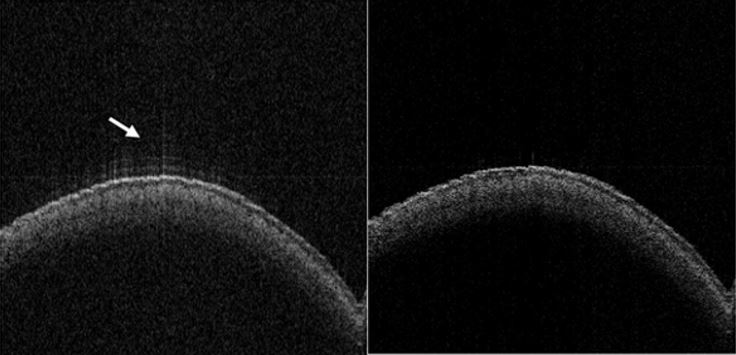
.png)